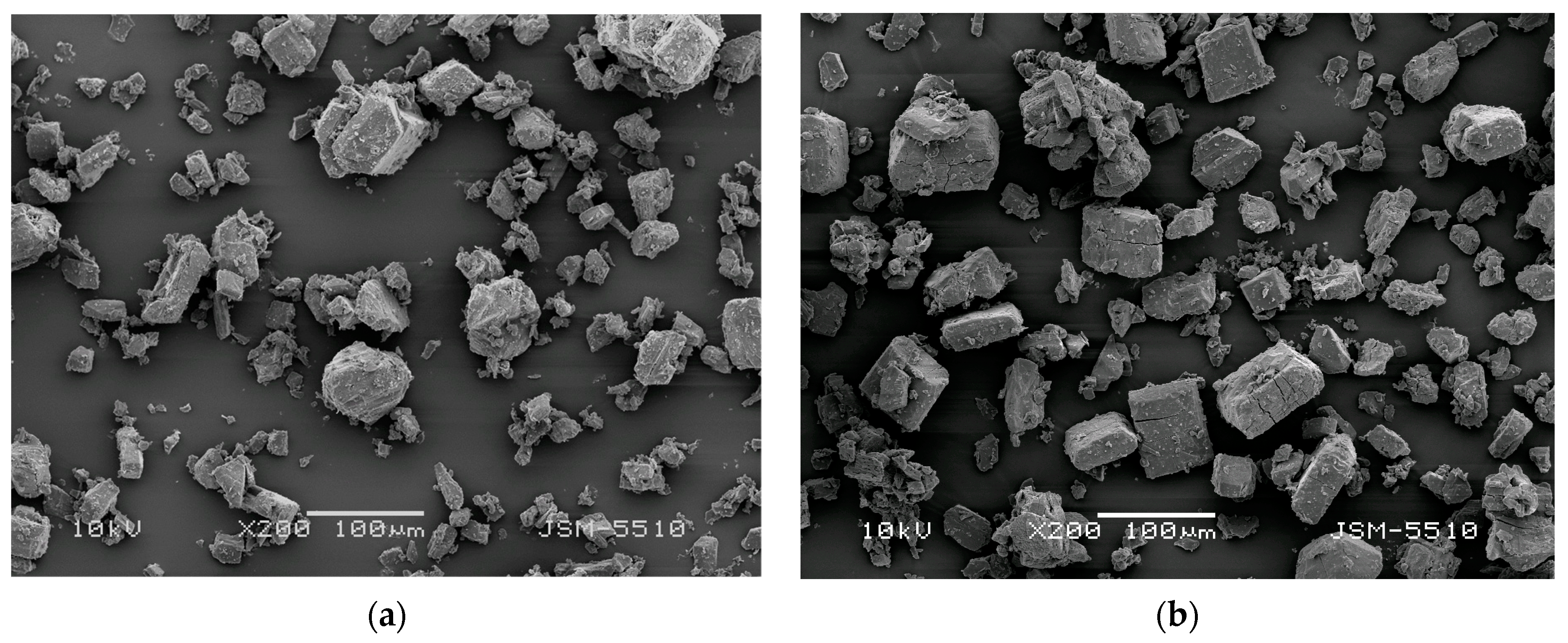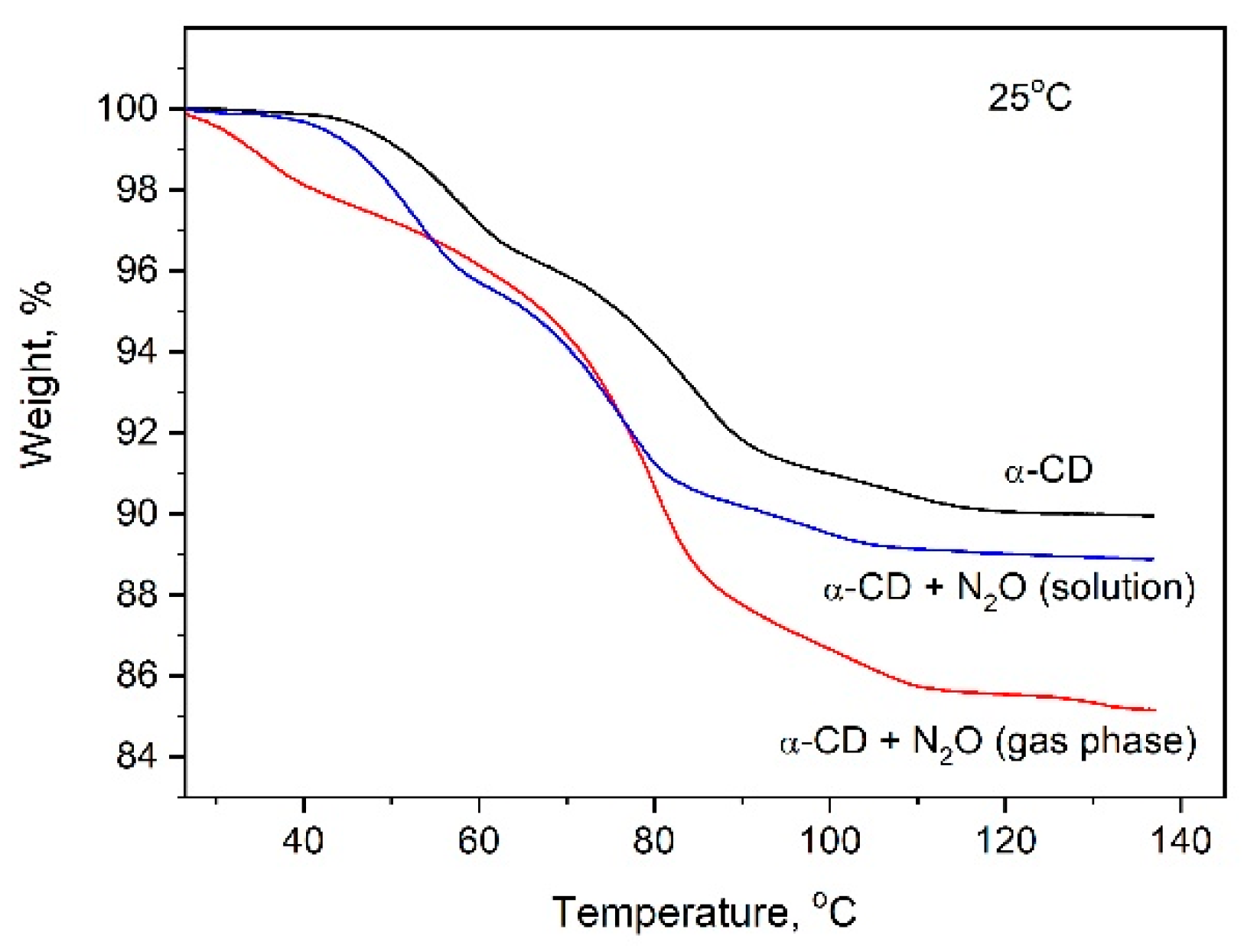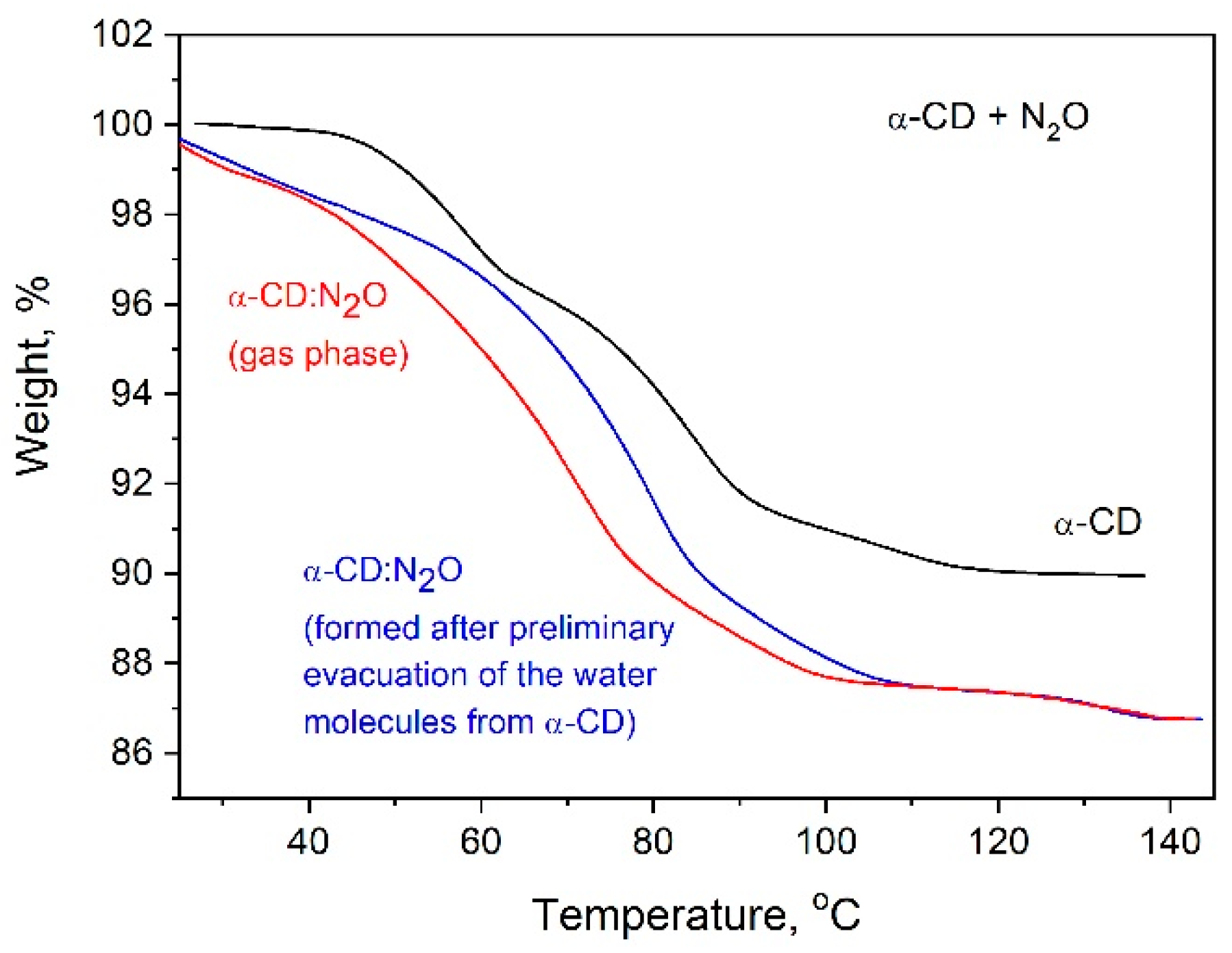Easy and Effective Method for α-CD:N2O Host–Guest Complex Formation
Abstract
:1. Introduction
2. Results
Theoretical Modeling
- The external coordination of the guest molecule to either the upper or lower rims of α-CD without dislodging hydration water molecule(s).[α-CD:6wat] + N2O → {[α-CD:6wat]N2O}
- N2O binding inside the central cavern of the cavitand accompanied by a water molecule displacement.[α-CD:6wat] + N2O → [α-CD:5wat:N2O] + 1watTaking into consideration the differences in the respective quantities between the products and reactants in the above equations, the enthalpy of the process, ΔH, was evaluated aswhere ΔpV is a work term accounting for the difference in the number of moles in the two sides of Equations (1) and (2); it is −0.59 kcal/mol for Equation (1) and 0 kcal/mol for Equation (2).ΔH = ΔEel + ΔEth + ΔpV
3. Discussion
4. Materials and Methods
5. Conclusions
Author Contributions
Funding
Institutional Review Board Statement
Informed Consent Statement
Data Availability Statement
Conflicts of Interest
References
- Bilensoy, E.; Duchene, D.; Ahuja, A.; Baboota, S.; Ali, J.; Mustafa, G.; Acartürk, F.; Celebi, N. Part 1, ch.1: Cyclodextrins and Their Inclusion Complexes; ch.2: Cyclodextrins as Potential Excipients in Pharmaceutical Formulations: Solubilizing and Stabilizing Effects, ch.3: Cyclodextrins as Bioavailability Enhancers. In Cyclodextrins in Pharmaceutics, Cosmetics and Biomedicine, 1st ed.; John Wiley & Sons, Inc.: Hoboken, NJ, USA, 2011; pp. 3–43. [Google Scholar] [CrossRef]
- Manakker, F.; Vermonden, T.; Nostrum, C.; Hennink, W. Cyclodextrin-Based Polymeric Materials: Synthesis, Properties, and Pharmaceutical/Biomedical Applications. Biomacromolecules 2009, 10, 3157–3175. [Google Scholar] [CrossRef] [PubMed]
- Loftsson, T.; Duchene, D. Cyclodextrins and their pharmaceutical applications. Int. J. Pharm. 2007, 329, 1–11. [Google Scholar] [CrossRef] [PubMed]
- Liu, L.; Guo, Q.X.J. The Driving Forces in the Inclusion Complexation of Cyclodextrins. Inclusion Phenom. Macrocyclic Chem. 2002, 42, 1–14. [Google Scholar] [CrossRef]
- Harries, D.; Rau, D.C.; Parsegian, V.A. Solutes Probe Hydration in Specific Association of Cyclodextrin and Adamantane. J. Am. Chem. Soc. 2005, 127, 2184–2190. [Google Scholar] [CrossRef] [PubMed]
- Davis, M.E.; Brewster, M.E. Cyclodextrin-based Pharmaceutics: Past, Present and Future. Nat. Rev. Drug Discovery 2004, 3, 1023–1035. [Google Scholar] [CrossRef] [PubMed]
- Ribeiro, A.; Figueiras, A.; Santos, D.; Veiga, F. Preparation and solid state characterization on inclusion complexes formed between miconazole and methyl-β-cyclodextrin. AAPS PharmSciTech 2008, 9, 1102–1109. [Google Scholar] [CrossRef]
- Brewster, M.E.; Loftsson, T. Cyclodextrins as pharmaceutical solubilizers. Adv. Drug Delivery Rev. 2007, 59, 645–666. [Google Scholar] [CrossRef] [PubMed]
- Uekama, K. Design and evaluation of cyclodextrin-based drug formulation. Chem. Pharm. Bull. 2004, 52, 900–915. [Google Scholar] [CrossRef] [PubMed]
- Mura, P.; Bettinetti, A. Interactions of ketoprofen and ibuprofen with β-cyclodextrins in solution and in the solid state. Int. J. Pharmaceutics 1998, 166, 189–203. [Google Scholar] [CrossRef]
- Salústio, P.J.; Feio, G. The influence of the preparation methods in the inclusion of model drugs in a β-cyclodextrin cavity. Eur. J. Pharm. Biopharm. 2009, 71, 377–386. [Google Scholar] [CrossRef] [PubMed]
- Deng, J.; Chen, Q.J.; Li, W.; Zuberi, Z.; Feng, J.X.; Lin, Q.L.; Ren, J.L.; Luo, F.J.; Ding, Q.M.; Zeng, X.X.; et al. Toward improvements for carrying capacity of the cyclodextrin-based nanosponges: Recent progress from a material and drug delivery. J. Mater. Sci. 2021, 56, 5995–6015. [Google Scholar] [CrossRef]
- Kumar, S.; Pooja, D.; Rekha, R. Cyclodextrin nanosponges: A promising approach for modulating drug delivery. In Colloid Sciences in Pharmaceutical Nanotechnology; INTECHOPEN: London, UK, 2020; Volume 79. [Google Scholar] [CrossRef]
- Tannous, M.; Hoti, G.; Trotta, F.; Cavalli, R.; Higashiyama, T.; Pagliaro, P.; Penna, C. Oxygen Nanocarriers for Improving Cardioplegic Solution Performance: Physico-Chemical Characterization. Int. J. Mol. Sci. 2023, 24, 10073. [Google Scholar] [CrossRef] [PubMed]
- Lachowicz, M.; Stańczak, A.; Kołodziejczyk, M. Characteristic of Cyclodextrins: Their Role and Use in the Pharmaceutical Technology. Curr. Drug Targets 2020, 21, 1495–1510. [Google Scholar] [CrossRef] [PubMed]
- Rincón-López, J.; Almanza-Arjona, Y.C.; Riascos, A.P.; Rojas-Aguirreet, Y. Technological evolution of cyclodextrins in the pharmaceutical field. J. Drug Delivery Sci. Technol. 2021, 61, 102156. [Google Scholar] [CrossRef] [PubMed]
- Buschmann, H.; Schollmeyer, E. Applications of cyclodextrins in cosmetic products: A review. J. Cosmet Sci. 2002, 53, 185–191. [Google Scholar] [PubMed]
- Kohler, P.; Petersen, R.-D.; Butchers, S. Stabilization of tea tree oil. SÖFW J. 1999, 125, 10. [Google Scholar]
- Kock, J. Storage of stable, powdered detergent and cleaning agent containing perfume. DE 1981, 30, 20–269. [Google Scholar]
- Bacon, D.R.; Trinh, T. Detergent Compositions Containing Enduring Perfume. U.S. Patent US5500154A, 19 March 1996. [Google Scholar]
- Kubota, M.; Komaki, R. Long-lasting perfume compositions containing (-) muscone. Jpn. Kokai Tokkyo Koho JP 1995, 7, 196. [Google Scholar]
- Trotta, F.; Cavalli, R.; Martina, K.; Biasizzo, M.; Vitillo, J.; Bordiga, S.; Vavia, P.; Ansari, K. Cyclodextrin nanosponges as effective gas carriers. J. Incl. Phenom. Macrocycl. Chem. 2011, 71, 189–194. [Google Scholar] [CrossRef]
- Astray, G.; Mejuto, J.C.; Simal-Gandara, J. Latest developments in the application of cyclodextrin host-guest complexes in beverage technology processes. Food Hydrocolloids 2020, 106, 105882. [Google Scholar] [CrossRef]
- Thao, M.H.; Bhandari, B.R. Encapsulation of Gases. In Functionality of Cyclodextrins in Encapsulation for Food Applications; Springer: Berlin/Heidelberg, Germany, 2021; pp. 29–51. Available online: http://hdl.handle.net/10138/566015 (accessed on 2 April 2024). [CrossRef]
- Johari, G.P. On the origin of the heat capacity feature of the annealed ices and ice clathrates and interpreting water’s diffusivity in term of the entropy. Chem. Phys. 2000, 258, 277–290. [Google Scholar] [CrossRef]
- Ho, B.T.; Joyce, D.C.; Bhandari, B.R. Encapsulation of ethylene gas into α-cyclodextrin and characterization of the inclusion complexes. Food Chem. 2011, 127, 572–580. [Google Scholar] [CrossRef] [PubMed]
- Mohammadi, A.; Manteghian, M.; Mirzaei, M. Effect of β-cyclodextrin on dissolution of methane in water. Chem. Eng. Res. Des. 2011, 89, 421–427. [Google Scholar] [CrossRef]
- Pereva, S.; Himitliiska, T.; Spassov, T.; Stoyanov, S.D.; Arnaudov, L.N.; Dudev, T. Cyclodextrin-Based Solid-Gas Clathrates. J Agric. Food Chem. 2015, 63, 6603–6613. [Google Scholar] [CrossRef] [PubMed]
- Chen, M.; Chen, X.; Yam, K. Encapsulation complex of chlorine dioxide in α-cyclodextrin: Structure characterization and release property. Food Control 2020, 107, 106783. [Google Scholar] [CrossRef]
- Lee, J.-U.; Lee, S.-S.; Lee, S.; Oh, H.B. Noncovalent Complexes of Cyclodextrin with Small Organic Molecules: Applications and Insights into Host–Guest Interactions in the Gas Phase and Condensed Phase. Molecules 2020, 25, 4048. [Google Scholar] [CrossRef] [PubMed]
- Song, W.; Zhang, M.; Huang, X.; Chen, B.; Ding, Y.; Zhang, Y.; Yu, D.G.; Kim, I. Smart l-borneol-loaded hierarchical hollow poly-mer nanospheres with antipollution and antibacterial capabilities. Mater. Today Chem. 2022, 26, 101252. [Google Scholar] [CrossRef]
- Liao, Q.; Kim, E.J.; Tang, Y.; Xu, H.; Yu, D.G.; Song, W.; Kim, B.J. Rational design of hyper-crosslinked polymers for bio-medical applications. J. Polym. Sci. 2024, 62, 1517–1535. [Google Scholar] [CrossRef]
- Gonzalez Pereira, A.; Carpena, M.; García Oliveira, P.; Mejuto, J.C.; Prieto, M.A.; Simal Gandara, J. Main Applications of Cyclodextrins in the Food Industry as the Compounds of Choice to Form Host-Guest Complexes. Int. J. Mol. Sci. 2021, 22, 1339. [Google Scholar] [CrossRef] [PubMed]
- Zeller, B.L.; Zeller, D.A. Gasified Food Products and Methods of Preparation Thereof. WIPO (PCT) WO2008036744A1, 19 September 2007. [Google Scholar]
- Gatiatulin, A.K.; Oselskaya, V.Y.; Ziganshin, M.A.; Gorbatchuk, V.V. Guest exchange in anhydrous inclusion compounds of α-cyclodextrin and its amorphization. J. Thermal Anal. Calorim. 2021, 146, 2417–2422. [Google Scholar] [CrossRef]
- Angelova, S.; Nikolova, V.; Pereva, S.; Spassov, T.; Dudev, t. α-Cyclodextrin: How Effectively Can Its Hydrophobic Cavity Be Hydrated? J. Phys. Chem. B 2017, 121, 9260–9267. [Google Scholar] [CrossRef] [PubMed]
- Gaussian 09, Version D.01; Gaussian, Inc.: Wallingford, CT, USA, 2013.
- Pereva, S.; Nikolova, V.; Angelova, S.; Spassov, T.; Dudev, T. Water inside β-cyclodextrin cavity: Amount, stability and mechanism of binding. Beilstein J. Org. Chem. 2019, 15, 1592–1600. [Google Scholar] [CrossRef] [PubMed]
- Pereva, S.; Nikolova, V.; Sarafska, T.; Angelova, S.; Spassov, T.; Dudev, T. Inclusion complexes of ibuprofen and β-cyclodextrin: Supramolecular structure and stability. J. Mol. Struct. 2020, 1205, 127575. [Google Scholar] [CrossRef]
- Nikolova, V.; Velinova, A.; Dobrev, S.; Kircheva, N.; Angelova, S.; Dudev, T. Host−Guest Complexation of Cucurbit[7]Uril and Cucurbit[8]Uril with the Antineoplastic and Multiple Sclerosis Agent Mitoxantrone (Novantrone). J. Phys. Chem. A 2021, 125, 536–542. [Google Scholar] [CrossRef] [PubMed]
- Uyar, T.; Nur, Y.; Hacaloglu, J.; Besenbacher, F. Electrospinning of functional poly(methylmethacrylate) nanofibers contain-ing cyclodextrin-menthol inclusion complexes. Nanotechnology 2009, 20, 125703. [Google Scholar] [CrossRef] [PubMed]
- Harata, K. Structural aspects of stereo differentiation in the solid state. Chem. Rev. 1998, 98, 1803–1827. [Google Scholar] [CrossRef]
- Manor, P.C.; Saenger, W. Topography of cyclodextrin inclusion complexes. III. Crystal and molecular structure of cyclohexaamylose hexahydrate, the water dimer inclusion complex. J. Am. Chem. Soc. 1974, 96, 3630–3639. [Google Scholar] [CrossRef]
- Dudev, T.; Spassov, T. Inclusion complexes between β-cyclodextrin and gaseous sub-stances—N2O, CO2, HCN, NO2, SO2, CH4 and CH3CH2CH3. Role of the host’s cavity hydration. Inorganics 2024, 12, 110. [Google Scholar] [CrossRef]











Disclaimer/Publisher’s Note: The statements, opinions and data contained in all publications are solely those of the individual author(s) and contributor(s) and not of MDPI and/or the editor(s). MDPI and/or the editor(s) disclaim responsibility for any injury to people or property resulting from any ideas, methods, instructions or products referred to in the content. |
© 2024 by the authors. Licensee MDPI, Basel, Switzerland. This article is an open access article distributed under the terms and conditions of the Creative Commons Attribution (CC BY) license (https://creativecommons.org/licenses/by/4.0/).
Share and Cite
Sarafska, T.P.; Spassova, M.I.; Dudev, T.M.; Pereva, S.M.; Stoyanov, S.D.; Spassov, T.G. Easy and Effective Method for α-CD:N2O Host–Guest Complex Formation. Int. J. Mol. Sci. 2024, 25, 5472. https://doi.org/10.3390/ijms25105472
Sarafska TP, Spassova MI, Dudev TM, Pereva SM, Stoyanov SD, Spassov TG. Easy and Effective Method for α-CD:N2O Host–Guest Complex Formation. International Journal of Molecular Sciences. 2024; 25(10):5472. https://doi.org/10.3390/ijms25105472
Chicago/Turabian StyleSarafska, Tsveta P., Maya I. Spassova, Todor M. Dudev, Stiliana M. Pereva, Simeon D. Stoyanov, and Tony G. Spassov. 2024. "Easy and Effective Method for α-CD:N2O Host–Guest Complex Formation" International Journal of Molecular Sciences 25, no. 10: 5472. https://doi.org/10.3390/ijms25105472




